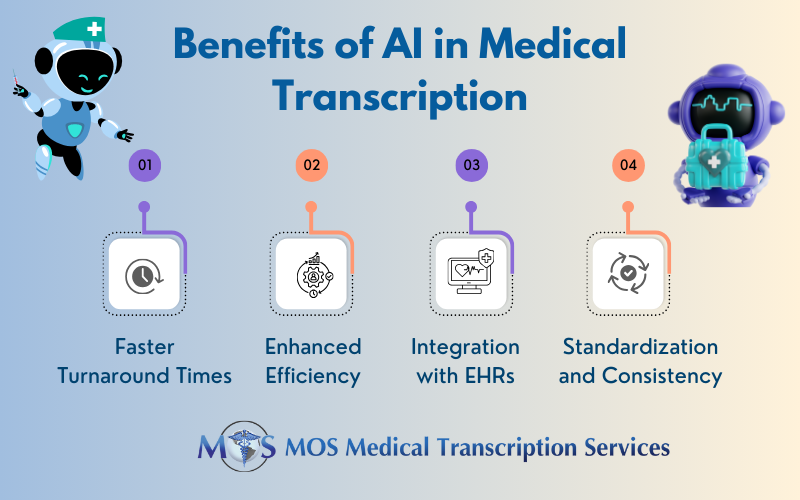 The medical transcription industry is changing along with many other industries due to the advent of artificial intelligence (AI). AI transcription technologies are becoming more and more integrated into healthcare practices as a result of advances in machine learning and natural language processing (NLP). While a medical transcription company traditionally relied solely on human transcriptionists to accurately transcribe medical records, AI is now automating significant parts of the process. Even though AI transcription shows promise, human assistance is still necessary in some situations.
The medical transcription industry is changing along with many other industries due to the advent of artificial intelligence (AI). AI transcription technologies are becoming more and more integrated into healthcare practices as a result of advances in machine learning and natural language processing (NLP). While a medical transcription company traditionally relied solely on human transcriptionists to accurately transcribe medical records, AI is now automating significant parts of the process. Even though AI transcription shows promise, human assistance is still necessary in some situations.
Table of Contents
The Impact of AI on Medical Transcription
AI is transforming medical transcribing by significantly improving speed and efficiency. Large amounts of medical data may now be instantly transcribed via speech-to-text technology due to AI-driven transcription technologies. With this automation, medical staff can produce medical records more rapidly, which lessens the administrative load and frees up doctors to concentrate more on patient care.
- Natural Language Processing (NLP): Artificial Intelligence (AI) medical transcription accuracy is further improved by Natural Language Processing (NLP) techniques. These can comprehend the meaning and context of words, making transcriptions more contextually appropriate. This is especially crucial in the healthcare industry, as accurate interpretation of medical data is vital.
- Automatic Speech Recognition (ASR): Artificial Intelligence (AI) transcribes spoken words into text using Automatic Speech Recognition (ASR). Accurate transcriptions are guaranteed by ASR systems, which are trained to identify medical language and jargon. Their ability to handle substantial amounts of audio data instantaneously shortens the time it takes to produce documentation.
- Integration with EHR Systems: Electronic Health Record (EHR) systems can be easily integrated with AI medical transcription systems, allowing for real-time patient record updates. By streamlining the paperwork process, this integration frees up healthcare personnel to concentrate more on patient care.
Advantages of AI for Medical Transcription

AI transcription assists the medical field in a number of important ways, including:
- Faster Turnaround Times: Artificial intelligence (AI) can transcribe audio files in a matter of minutes. Fast processing is very useful in healthcare environments where patients have limited time, such as emergency rooms or urgent care centers
. - Enhanced Efficiency: AI transcription is capable of processing several inputs simultaneously, including consultations, procedural paperwork, and medical dictation. For medical practitioners, this multitasking capacity optimizes efficiency and boosts productivity.
- Integration with EHRs: Many AI transcription systems are designed to effortlessly interact with existing electronic health record systems. This guarantees that patient data is accurately recorded and readily retrievable while streamlining the documentation process.
- Standardization and Consistency: Medical terminology and formatting can be highly consistent when using transcribing technologies driven by artificial intelligence. This guarantees standardized documentation and lowers the possibility of errors resulting from human variability.
Limitations of AI in Medical Transcription and the Role of Human Intervention
For many healthcare practitioners, AI transcription is revolutionary, but it is not without drawbacks. AI transcription systems encounter a number of difficulties, and this is where human transcriptionists continue to be quite important.
- Complex Terminology Accuracy Issues: Despite notable advancements, AI is still not perfect when it comes to medical jargon, dialects, accents, or even the context of specific sentences. Precision is essential in complicated medical situations, and AI might not always be able to fully catch all the subtleties.
- Data Privacy concerns: The security and privacy of sensitive patient data transcription call for the highest attention. Cloud-based AI systems could be risky if they are not adequately safeguarded. Human supervision can guarantee data security and compliance with laws such as HIPAA.
- Quality Control Requirement: While AI transcription technologies may generate transcripts rapidly, human editors are still required to check and fix any errors. This quality control procedure guarantees that the finished product is error-free and suitable for usage in clinical settings.
- Contextual Understanding: While AI systems are capable of transcribing text, they frequently lack the contextual knowledge required in specific medical situations. For instance, homophones—words that have similar sounds but distinct meanings – can easily mislead AI transcription systems, resulting in mistakes that may jeopardize patient care.
The limitations of AI in medical transcription highlight the importance of maintaining a balance between automation and human oversight. While AI transcription systems can handle a majority of the transcription workload, human transcriptionists remain invaluable in ensuring accuracy, especially in cases involving complex medical terms or unique patient scenarios. A medical transcription company that leverages both AI technology and experienced human editors can offer the best of both worlds, providing fast and reliable transcription services while minimizing errors.


